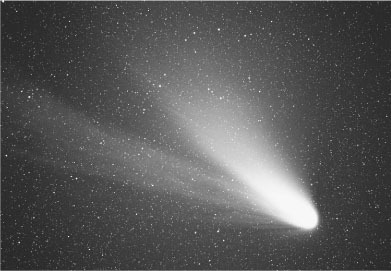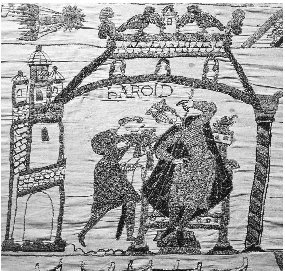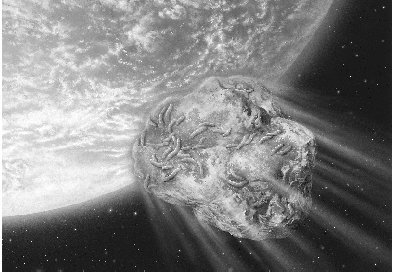Introduction
Mountains in the Sky
If a person goes outside on a clear, moonless night in the countryside, far from city lights, he or she will be treated to a breathtaking sight. Above stretches a velvet black canopy studded with thousands of pinpoints of light, some bright and lustrous, others so faint they are barely visible. Most of these, of course, are stars like the Sun, except that they lie much farther away than the huge gaseous ball whose light and heat make life on Earth possible.
A few of the brighter points of light in the dark canopy are planets in our own solar system, the Sun's family. But these few easily visible solid bodies, each thousands of miles in diameter, are only the tip of the iceberg, so to speak, of the material making up the solar system. Lurking in the darkness among them, usually invisible to unaided human eyes, are billions of smaller objects. Some are no larger than cars or houses, while others are five, ten, fifty, or a hundred miles across. "Lost amid the stars," writes noted science historian Curtis Peebles, "there are mountains in the sky. Some are worlds in their own right, others are the irregular splinters of collisions [that happened] ages ago." 1
Those orbiting mountains that are composed mainly of metal and rock are known as asteroids, while those made up mostly of ice and rock are comets. Because of their relatively small size (as compared to planets and stars), most asteroids and comets are difficult to see without the use of a large telescope; however, on occasion a comet will grow a tail and pass near enough to Earth to become visible to the naked eye.
Disaster and the Deaths of Princes
For these reasons, no one knew about the existence of asteroids until modern times, when large telescopes became common. In contrast, people have seen comets since ancient times, indeed since modern humans first appeared on Earth more than a hundred thousand years ago. Over the centuries,various peoples assigned names to these objects, and because comets have such a distinct look–like fuzzystars with cloud like tails–most of the names are similar to one another. The ancient Chinese called them "broom stars," for example. The Aztecs, who dwelled in what is now Mexico, called them "smoking

Whatever the ancients chose to call comets, nearly all agreed that these objects were omens, or supernatural signs, of one kind or another. The most common view was that they foretold coming disasters or ill fortune. An ancient Chinese document titled Record of the World's Change states:
Comets are vile stars. Every time they appear in the south, something happens to wipe out the old and establish the new. Also, when comets appear, whales die. In Sung . . . times, when a comet appeared in the constellation of the Big Dipper, all soldiers died in chaos. . . . When a comet appears in the North Star, the emperor is replaced. If it appears in the end of the Big Dipper, everywhere there are uprisings and war continues for several years. If it appears in the bowl of the Dipper, a prince controls the emperor. Gold and gems become worthless. . . . Scoundrels harm nobles. Some leaders appear, causing disturbances. Ministers conspire to rebel against the emperor. 2
The other common belief regarding cometary omens was that they signaled the birth, death, or military victories of great kings, generals, and other human leaders. The immortal English playwright William Shakespeare summarized it best in a famous line from his play Julius Caesar: "When beggars die, there are no comets seen; the heavens themselves blaze forth the death of princes." 3 In fact, the passing of the real Julius Caesar, some sixteen centuries before Shakespeare wrote these lines, was said to have been marked by a comet. According to Caesar's Greek biographer Plutarch: "Of [the] supernatural events [marking Caesar's death] there was, first, the great comet which shone very brightly for seven nights after Caesar's murder and then disappeared." 4 Similarly, in Plutarch's own time, a comet that became visible in A . D . 79 was widely believed to be associated with the death of the Roman emperor Vespasian. (The idea that comets were harbingers of disaster was still commonplace; in A . D . 66, a bright comet was seen as an omen of the destruction of the city of Jerusalem that year by the Romans.)
The Voice of Reason Ignored
Not all of the ancients were convinced that comets were completely supernatural, however. The Greek philosopher-scientist Democritus (born in 460 B . C .) was the first known person to suggest that these celestial objects might have natural origins. He proposed that comets existed among the distant stars and planets and formed when one of these bodies came too near another. In the following century, the more influential Greek thinker Aristotle disagreed. In his view, comets were natural, but they existed inside Earth's own atmosphere—the result of hot, dry gases seeping out of the ground and igniting high in the air.
A few centuries later, the Roman playwright and thinker Seneca the Younger declared that Aristotle was wrong. In a treatise titled On Comets , the seventh book of a larger work, the Natural Questions , Seneca argued that comets could not be moving through the atmosphere. If they were, he said, the wind should disturb their movements, yet even after a sudden storm a comet stayed on its stately path. Seneca was not exactly sure what comets were. But he had the humility to admit it and the foresight to predict that future scientists would discover the truth. "The day will come," he wrote,
when the progress of research through long ages will reveal to sight the mysteries of nature that are now concealed. A single lifetime, though it were wholly devoted to the study of the sky, does not
suffice for the investigation of problems of such complexity. . . . It must, therefore, require long successive ages to unfold all. The day will yet come when posterity [future generations] will be amazed that we remained ignorant of things that will to them seem so plain. . . . The man will come one day who will explain in what regions the comets move, why they diverge so much from the other stars, what is their size and their nature. Many discoveries are reserved for the ages still to be when our memory shall have perished. . . . Nature does not reveal all her secrets at once. 5 This drawing of Democritus, the first scientist to suggest comets are natural objects, is fanciful. No one knows his actual appearance.
This drawing of Democritus, the first scientist to suggest comets are natural objects, is fanciful. No one knows his actual appearance.
Seneca's voice of reason regarding comets and other aspects of the heavens had little or no effect on the thinking of later generations. In medieval times, the ancient superstitions about comets continued to prevail. In the seventh century, Isidor, Bishop of Seville, an influential Christian historian, declared that comets foreshadow wars and disease epidemics. And the fact that from time to time comets did materialize during wars was enough to convince most people that the bishop must be right.
In 1066, for instance, a bright comet appeared just as William the Conqueror was invading England. The common belief at the time was that this apparition was an evil omen for England's King Harold, and indeed, Harold soon went down to defeat, initiating the Norman occupation of the country. (The well-known Bayeux Tapestry, celebrating the Norman victory, shows the comet, which modern scientists now agree is the famous Halley's comet in one of its many periodic visits to Earth's neighborhood.)


Incredibly, a certain degree of fear and awe of comets continued into modern times, even after science showed conclusively that these objects are simply stray chunks of ice and rock roaming the solar system. When Comet Biela passed close to Earth in 1892, for example, terror gripped many people across the globe. Typical of the reactions were those reported in an Atlanta, Georgia, newspaper:
The fear which took possession of many citizens has not yet abated. The general expectation hereabouts was that the comet would be heard from on Saturday night. As one result, the confessionals of the two Catholic churches here were crowded yesterday evening. As the night advanced, there were many who insisted that they could detect changes in the atmosphere. The air, they said, was stifling. . . . Tonight (Saturday) they [the churches] are all full, and sermons suited to the terrible occasion are being delivered. 6
Cosmic Connections to Humans?
Today, by contrast, astronomers and other scientists view comets and their cosmic cousins, asteroids, as more fascinating than frightening and find that much can be learned from studying them. Both of these classes of celestial bodies have been around for billions of years. So they offer important clues to conditions in the solar system during its early years.
In addition, comets and the materials composing them may well have crucial connections to human beings and other life on Earth. "Comets are the least understood objects in the solar system," says NASA comet expert Donald Yeomans. "And they're probably the most important when it comes to you and me." 7 Yeomans is referring to the current theory that much of the water on Earth was delivered by in-falling comets, as well as another hypothesis that organic compounds in comets brought the precursors of life to our planet.
The very fact that comets, and asteroids too, do occasionally fall to Earth is another reason that these bodies are important to humans. Nearly all scientists now accept that the impact of a comet or asteroid wiped out more than half the animal species on the planet, including the dinosaurs, 65 million years ago. Such disasters can and will happen again in the future. Ironically, therefore, ancient fears of these objects were not totally misplaced, even if the reasons given in those days were wrong. What is certain is that the more we study and understand these bodies, the better chance we have of controlling them and keeping them from wiping out human civilization. After all, it is and always will remain in the best interest of everyone for the millions of mountains that hurtle through the sky to stay in their own domain.
Comment about this article, ask questions, or add new information about this topic: